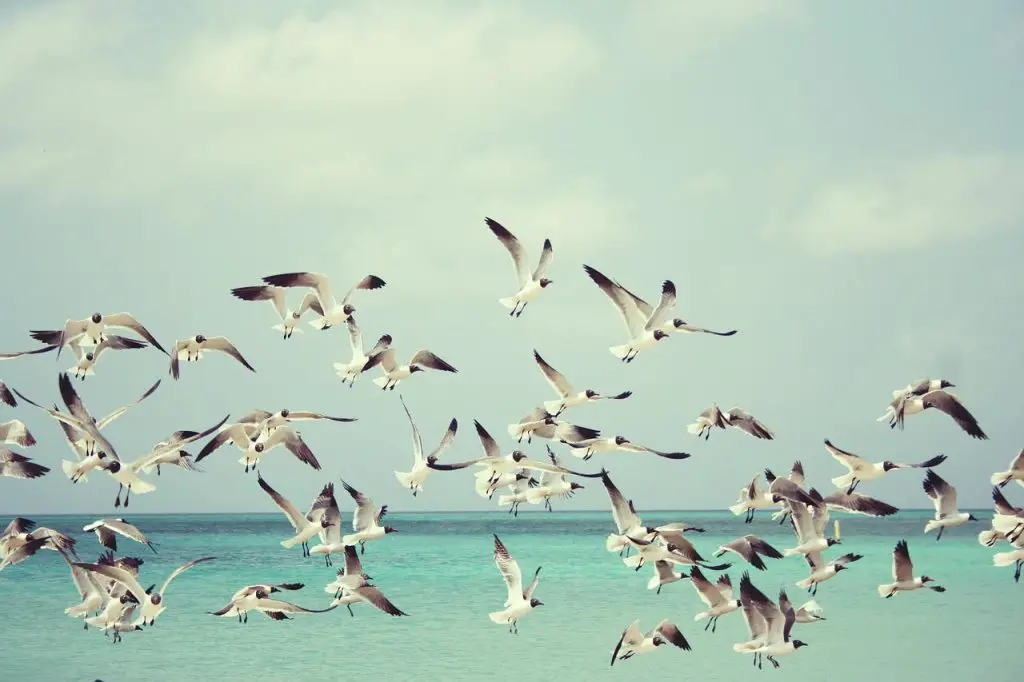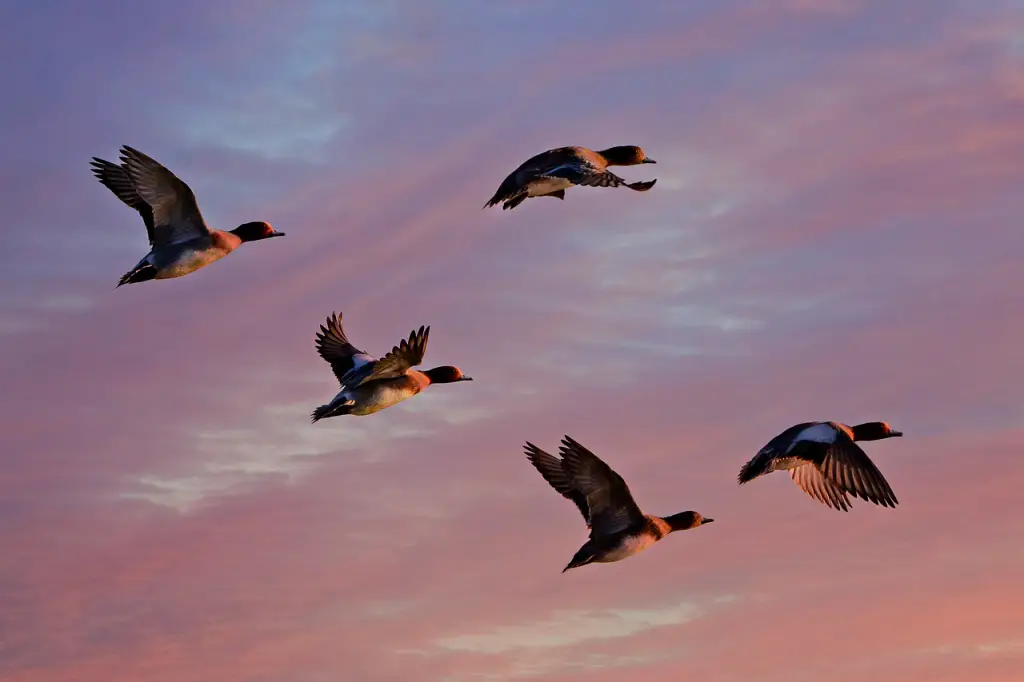Birds are undoubtedly the most successful class of vertebrates today, with over 10,000 species. Their success is greatly owed to their ability to migrate and, consequently, the wide range of habitats that flight provides.
To fly, birds need to produce lift and propel themselves forward. These are created using their muscles and the shape of the wings. The wings cut through the air, allowing air to flow around, and the beating of their wings propels them forward.
If you want to know more, please read on.

Flight Mechanism
The mechanical challenge with flight is lifting a weight off the ground, maintaining it airborne for an extended period, and pushing it forward simultaneously. An upward force (lift) and a forward force (propulsion) are necessary.
A model aircraft’s wing cross-section reveals the solution to this difficulty. An aerofoil section is rounded and thicker at the front than at the slender ‘trailing edge,’ shallowly convex above and concave below.
Moving an aerofoil section through the air causes air to flow across its surfaces, producing lift. The invention of the aerofoil section enabled man to fly; birds have been using it for eons. A classic aerofoil section can be found in the inner portion of a bird’s wing, which is physiologically analogous to the human forearm.
Next, they need propulsion. Birds rely on beating their wings, which are powered by highly developed pectoral muscles. The outer section of the wing, from the angle (where the front edge bends) to the tip, provides propulsion. The primary feathers are often longer to make it easier to glide.
As the downstroke is made, the wings move forward and push backward at the bottom of the stroke. Because the feathers are held together firmly, they cut through the air like a knife.
On the upstroke, the primary feathers twist. This leaves a little space that allows air through to reduce resistance to the upstroke.
This section is anatomically identical to the human hand, from the wrist to the fingertips. The ten or twelve long, powerful feathers near the tip of the wing (the flying feathers) are critical and deserve the technical term “primaries.”
Do you know how to identify birds from their droppings? Find out in this article I wrote
Made For Flying
The wings and tail of most aircraft are securely fixed in place, and only the presence of flaps and ailerons allows their shape to be adjusted so that the aircraft can be maneuvered. Some of the most advanced modern fighter planes are known for their “variable geometry,” which allows the wings to swing in and out of the fuselage. However, they cannot move in the air as easily as birds.
Birds can move their feathers, allowing the surrounding air to move in, above, or below. This allows them to maneuver much easier and quicker than even some of the most technically advanced aircraft.
As a result, it is clear to observe how much more maneuverable birds are than aircraft, with an almost endless range of positions, not just of the wings and tail, but of the portions of the wings and, in some cases, individual feathers.
Takeoff and Landing
Birds must be able to take off and land at will to complete their maneuverability. Many survive because they can do so at a moment’s notice, avoiding the constant threat of attacking predators. The maximum amount of propelling force that the bird is capable of producing is required for takeoff.
Smaller animals can exert enough effort to lift themselves off the ground without needing a run. On the other hand, heavier birds must survive without the capacity to respond to danger by taking off immediately.
Large waterbirds, such as swans and the great northern diver, find protection by spending much of their time on open water, far from predators on land. Their take-off is so tricky that they frequently have to ‘race’ over the sea surface, and they can only occupy lengths of water large enough to accommodate this extended take-off.
Birds must reduce the lift provided by their wings and tails during flight to land. Raising the tail is one way to minimize lift and maneuver into a fall towards the landing spot. Birds rear up in mid-air to an upright position to stop their flight.
They approach the chosen location. This tilts the wings nearly vertical, allowing them to act as ‘brakes’ or even beat against the direction of flight. The tail is dropped and serves as a brake against forward motion.
Flexible legs and strong muscles absorb the hard landing impact, linked to the bird’s pelvis, which is united to the lower spine for increased strength.
How do birds fight? Find out in this article I wrote
Shape of Wings
Throughout evolution, bird families have gained the ability to fly in various ways to suit the varied types of living they have adopted.
First, numerous birds do not have specialized flying wings but a general-purpose wing layout. The lift and power parts of the wing are about similar in length in this configuration. The wing measures twice as long as it does wide. This group includes garden birds such as the greenfinch and the robin. Larger birds, such as geese, do as well.
If the ‘general purpose’ category is placed in the middle of a spectrum of flight styles, ‘high maneuverability’ is one of the extremes on the scale. Birds in this group have wings with similar length lift and power portions. However, the wing seems rounder rather than lengthy, as it is almost as broad at its base as it is long from base to tip.
Game birds require a rapid and virtually vertical take-off to evade predators, and birds with dense cover, such as the small wren, are two examples. This wing pattern delivers great propulsion, while the large wing area results in high maneuverability.
The birds specializing in ultra-efficient flight are at the other end of the spectrum. Flight is developed to the highest performance levels among these species. Their wings do not have the same proportions as other bird species for optimal speed.
The power component of the wing (the major feathers) is substantially longer than the lift section—by a factor of four in some cases—and the wing is long and thin.

Five Types of Flight
General purpose: All round birds such as robins, geese, and finches.
High performance: High-performance birds have long, narrow primary feathers that give least air resistance and maximum power. High-performance birds include swifts, swallows, and the hobby.
High Maneuverability: Birds in this category such as the partridge and the wren are excellent at being able to get into and out of almost any situation with their highly skilled flights.
Gliding: Gliding birds are characterized by having wings with a long lift section to glide above the sea or land.
Soaring: These also have wings with long lift sections to catch thermals and air currents.
Soaring and Gliding
There are two methods to glide. In the case of birds, gliding is flying without flapping wings. There are two types of birds that are adapted for this form of flight: those that use wind power to go over the sea (gliding) and those that not only glide but also use rising air currents to gain height (soaring).
The ‘gliding’ birds have exceptionally long and narrow wings with a lift section that is as long as or longer than the power part. Most of them are oceanic birds, best represented by the southern hemisphere’s albatrosses and by the fulmar, gannet, and Manx shearwater in British seas.
Many birds, including ravens, buzzards, kestrels, and eagles soar in a slow circling climb to exploit thermals. Thermals are upward currents created when the suns warmth causes the air to rise.
Upcurrents at a ridge of hills or, under warm weather, columns of rising air known as thermals are used by flying birds. These currents are the domain of vultures in warmer countries, but the raven, buzzard, and golden eagle provide the best instances of soaring flight in Britain and Ireland.
These birds have a distinct appearance from the seagoing gliders: they, too, have a lift part that is as long as or longer than the power section, but their wings are much wider. Furthermore, rather than being pointed, the wingtips have a broadly splayed ‘fingers’ appearance, which helps to lessen turbulence. The birds fly in vast circles, slowly and laboriously, but they soar effortlessly once they catch the rising air.
Golden eagles soar on the breeze. They use their primary feathers which they spread out to use the air currents. The feathers are also shaped to reduce turbulence which helps them gain speed when gliding downwards.
Why do birds face the same direction on power cables? Find out the reason here


